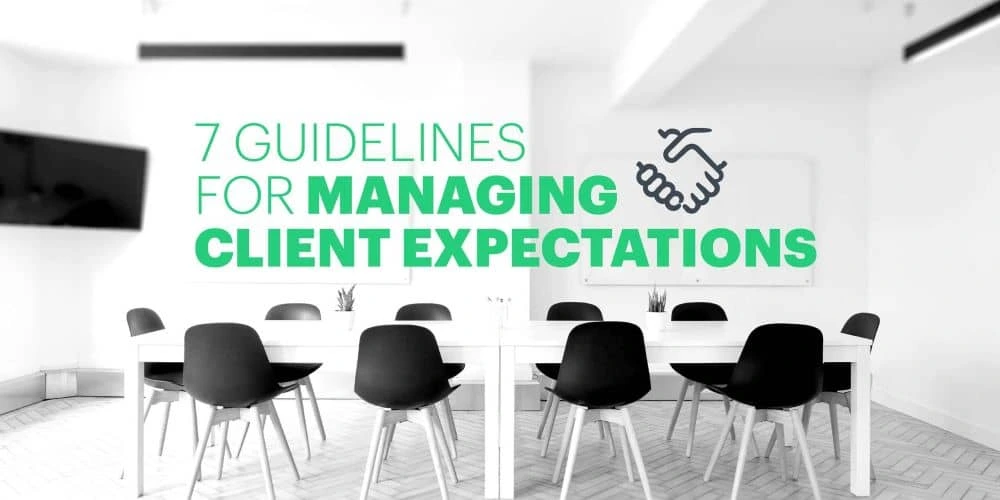Managing a client’s expectations is not an easy task, especially if you are a designer. As much as you want to keep clients happy and live up to their expectations, things don’t always go according to plan.
While designers rely on their creativity to deliver great results, clients sometimes undervalue the effort or attempt to control the process. It’s a cycle that can make even the most ambitious projects crumble in a matter of seconds. This is why maintaining good rapport with clients is instrumental to a project’s success. Although there’s no one-size-fits-all solution, we have some ground rules that can help you manage client expectations and take your collaboration to a whole new level.
Related: Essential client onboarding checklist
1. Communicate your ideas clearly
Communication is an integral part of any successful project. To maintain good communication, keep it simple. Communicate your ideas without using professional terms or slang that your clients might not be familiar with or understand. Also, don’t depend only on words. Share examples and visuals to help clients conceptualize the goal you’re trying to achieve. This way, you set up clear ideas from the start—and leave less room for misinterpretation down the road.
2. Set clear boundaries
No matter how smoothly we try to meet a client’s expectations, there will always be a few bumps in the road. For example, after sending over your first mockup, clients will nearly always request changes. This is an expected part of successful collaboration. If, however, they continue asking for alternatives time and time again, this may lead to revising the entire design, extending deadlines and causing frustration on both sides.
While it’s perfectly normal to listen to your client’s feedback and answer their needs and requirements, falling into a never-ending cycle of revisions will not have a positive effect on the project—or your relationship. To avoid this scenario, set clear boundaries; be transparent about what you can achieve and how much time you can dedicate to revisions. Otherwise, the client might undervalue your knowledge and skills and eventually stop trusting you.
3. Define your communication channels
The easiest, most efficient way to nurture a client is to keep them regularly updated about your progress and any changes. However, thanks to the inbox overload we all face, communicating with your client via email may no longer be enough. Build trust with your client by letting them become an integral part of your project, follow its different stages, comment and give feedback. Here’s a comparison list of the best project management tools that give clients a clear view of what you’re working on.
4. Identify your key contacts
While keeping your client regularly updated is important, too many messages between your team and your client may lead to annoyance, confusion or burnout. To prevent this, select one point of contact between the client and the design team. This will streamline communication so it’s straightforward and easier to prevent any misunderstandings or conflicts from bubbling over.
5. State your payment terms
Whether you need more resources to complete a project or you’ve run into an obstacle that you must tackle before moving forward, there are many reasons to extend project deadlines. If this happens, it’s better to ask your client to pay in parts rather than the entire sum. This makes it easier to add late payments and fill any gaps before it’s too late. Make sure you state your payment terms clearly and as early as possible so it’s a win-win situation for you and your client.
6. Make it personal
Small gestures can do wonders. If you’re working with a client who’s willing to pay for your services and appreciates your work and time, you should nurture the relationship by going above and beyond. For example, send them a personalized thank you card. Whether you provide advice that might have a positive impact on the brand, invite them to a fun activity or take them out for lunch, it will encourage ongoing collaboration in the future.
7. Have a detailed contract
A clear and concise contract is a major prerequisite to successful communication and collaboration with a client. Your contract should cover the following items:
- Expected working hours
- Procedure for feedback & revisions
- Project milestones
- Budget & payment
Keep in mind that besides delivering a contract to your client, you must carefully review it with them to make sure they understand and agree to all the details.
The best projects are a result of clients and designers working together to achieve a common goal, and the expectations you set will influence how the project’s success is perceived. By following these 7 guidelines, you’ll create a respectful, collaborative environment that will encourage everyone to do great work together.



